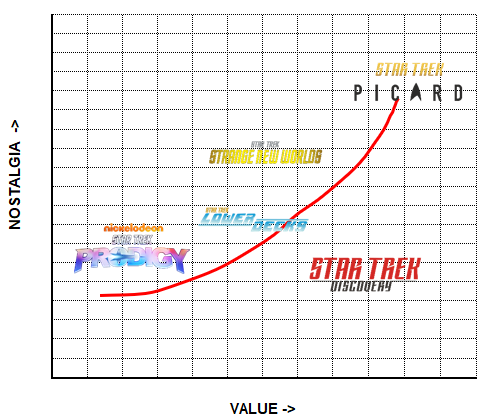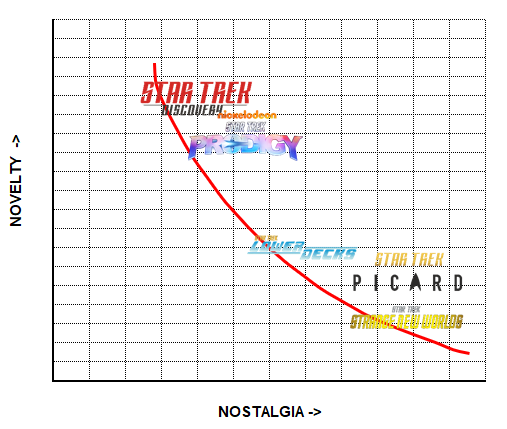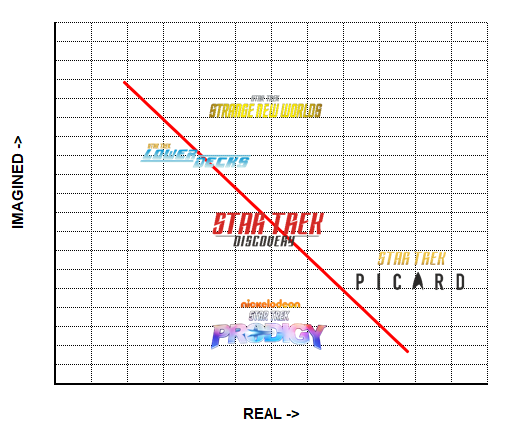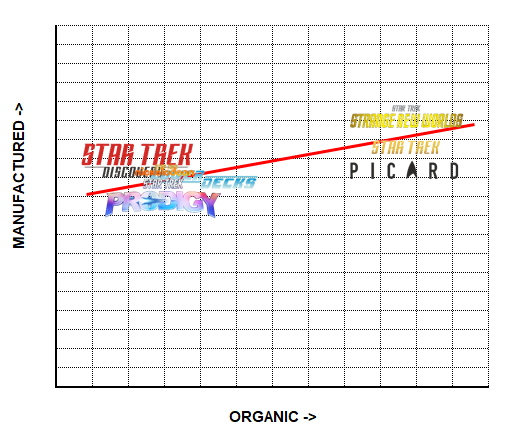(this was originally published as Implausipod Episode 35 on August 31st, 2024)

https://www.implausipod.com/1935232/episodes/15669349-e0035-the-nostalgia-curve
The box office for the summer of 2024 has been driven by titles relying heavily on the audiences nostalgia, with titles like Deadpool and Wolverine and Alien: Romulus leading the charge. But nostalgia as a driver for the movies isn’t new, and we’re seeing nostalgia across all areas of our society as well. So what’s going on? What are the factors that places something along The Nostalgia Curve?
In the summer of 2024, some of the biggest movies released were throwbacks to the past, sequels, or new entries in long standing franchises. But that’s no surprise, that’s been the way Hollywood operates for decades now. What was unique was the extent that these titles, like Deadpool and Wolverine and Alien Romulus, explicitly called out their past.
Part of their value proposition, the Pitch that allowed them to get made was that they were operating on the Nostalgia Curve. And what exactly is that? Well, stay tuned, we’re going to find out about it in this episode of The ImplausiPod.
Welcome to The ImplausiPod, an academic podcast about the intersection of art, technology and popular culture. I’m your host, Dr. Implausible. And despite what you might hear in certain places, Hollywood is actually a fairly conservative town. And by conservative, we mean that it’s risk averse. When you’re playing around with big money, you want to make sure you get a return on your investment, and Hollywood is a very much a big money town.
This risk aversion lends them to trade in established properties, which is why you’ll see a hundred sequels or adaptations or remakes in a given year before you see something truly original. That isn’t to say that there isn’t anything creative taking place, it’s just that it’s constrained, it’s operating within certain limits, and these limits can often be defined by the nostalgia that a title evokes.
The characters, the scenes, the lines, the callbacks, all the expectations that an audience has for a long run property. In a YouTube video by the channel ScreenPrism discussing Twin Peaks: The Return, the authors note that nostalgia can act as a bridge. Balm, that’s B-A-L-M. Soothing the audience by giving them what they want, but to effectively use it.
There always has to be a tension there, and the audience might not know that they’re going to get what it is that they hope for. There’s nothing inherently wrong with that. Liking what you like and asking for, and maybe even getting more of it when it is available. And this is most noticeable in some of the more longer running, and let’s call them “eternal” fandoms.
Things like Star Trek, and pro wrestling, and comic books. And I know those cross the boundaries between different types of media, and different art forms, really. But, those fandoms have endured for decades, through ups and downs, through periods of cultural relevance, to cultural obscurity, and back again.
And I think that makes them interesting to look at to illustrate the nostalgia curve, to see how these fandoms relate to and engage with new material produced for them. Now, these fandoms aren’t exactly equivalent, but they’re more alike beneath the surface than is usually acknowledged. All three of them cater to niche fandoms and have persisted long enough that most of the population has had the opportunity to engage with them at some point in their lives.
The slipping in the In and out of the zeitgeist that comes with the success of waves of popularity is a critical part of that. As nostalgic parents introduce their children to the media and by extension, the fandoms that they enjoyed when they were younger. Both comic books and pro wrestling live in this weird kind of eternal now that can acknowledge and play off their history.
And often they use this as a means of generating credibility or cachet, but continually inexorably, they have to put out new product. Weekly or monthly, and sometimes they’ll reintroduce old characters in a new way to play off that, either through legacy characters, or children, or relatives of past performers, but the trends are largely the same.
Star Trek is different, for the most part, as it continually has to create new stuff that is kinda like the old stuff, but still new and distinct enough that the fans will enjoy it. Witness the titles that have been put out under the Star Trek brand banner during the streaming era. With the dichotomy between Discovery, Picard, the Lower Decks, Prodigy, and the Strange New Worlds all coming out during roughly the same time period, and all engendering different reactions as they touch down on different points along the Nostalgia Curve.
Now, obviously other properties play with the nostalgia curve at times too, especially long running ones like Star Wars and Doctor Who come to mind, and gaming titles like Dungeons and Dragons, Magic the Gathering, Pokemon and Warhammer 40, 000 are all getting old enough to test the waters as well. So let’s maybe get to the point.
What is the nostalgia curve? Maybe it’s best to think of the amount of nostalgia a given property can evoke as existing along a gradient or a continuum or something like that.

When something appears in a long running piece of media, one with an inherent fandom, it can be a challenge to separate something from appearing for nostalgia purposes, i. e. marketing or whatever, and something existing just because it’s part of the setting. Like how do you differentiate between a trope, something that makes Star Wars, “Star Wars”, like a Wookiee or a lightsaber or whatever, and something that’s showing up just to evoke that nostalgia.
It’s not like Wookiees are going to disappear until a new shows shows up 20 years from now. Wookiees aren’t going anywhere. I mean, they’re. Like Top 5 Furry Beasts, easily. But, back on topic, is that the commodification of nostalgia, where whether or not a given movie or project even gets made, depends on how much the perceived nostalgia factor is worth.
And this is what’s really the issue. If the perceived value is enough, if you’re far along the nostalgia curve, then the movie can get made and the Hollywood being a place where money talks as we mentioned earlier It may be worth trying to create nostalgia for something that never existed in the first place if you can create or Incept I guess a fake thing which evokes real nostalgia or I guess let’s call it uncanny nostalgia from here on out We might have to work a focus group or something to actually get the name going, but then if you have this incepted nostalgia, this uncanny nostalgia, you can commodify that in the same way that the recent Deadpool movie did with Wolverine showing up and the quote unquote “comic book accurate” costume that still isn’t 100 percent there.
Basically. All these elements of nostalgia are memes, or what we think of as memes. () Have we done the meme episode yet? If not, we’ll put that into the near future.) But, nostalgia is representational, in a memetic way. Like, earlier in the flick, where Deadpool explicitly calls out the montage during a fourth wall break, and each scene in the montage is iconic within the comic books, and instantly recognizable to a longtime fan of those books, Even though they never have occurred on screen at any point prior.
Every point of nostalgia is an assemblage, or container, or docker, or however you like to term these things, for all the associations that accompany it. And these are all shorthand for everything else that is associated with those books. And this everything can include the year of publication, the era that they were published in, the creators, writers, writers, artists, editors, the events that they occurred in, whether it was like age of apocalypse or secret wars or fall of the mutants or something, all of these elements are compacted and drawn within these images and scenes that we see.
You can’t evoke a scene from the Age of Apocalypse comic book series and put it in a movie without drawing in all those other associations with it. Thus, each and every nostalgic element that’s put in the movie packs in more and more until a metatextual movie like Deadpool and Wolverine can’t help but burst at the seams.
But at least in the case of Deadpool and Wolverine, it feels deserved. A recent IGN review of Deadpool and Wolverine lumped the movie in with the adaptation of Ready Player One, a film that was similarly stuffed to the brim with hey I recognize that moments and criticized it as being one of Steven Spielberg’s Now, Spielberg has probably forgotten more about making fantastic movies than most any human will ever know.
So, were the failures of Ready Player One Spielberg’s fault, or was he simply being faithful to the source material? I’m asking because, honestly, I couldn’t stand the book, and punted it, and decided not to watch the movie when it came out. Seeing the trailers made it feel gimmicked and trying too hard, and I Noped out of it well in advance, whereas, as I said, with Deadpool and Wolverine, it seemed earned.
What I’m getting at here is that nostalgia is a hot commodity. It isn’t going away anytime soon, and even though we all yearn for something fresh and new and endlessly scrolling on our apps of choice to find it, we end up finding community and joy in our shared nostalgia for things we’re pretty sure we never saw.
Or at least not the way we imagine them to be. And I think that in and of itself is worthy of exploring.
In order to explore the nostalgia curve, we need to lay out some basics, set down our foundation. We’ve been describing how nostalgia functions as a factor in the calculus of content production, how it feeds into the algorithm of whether something gets made. So that leads us to question, how do we determine the value of nostalgia?
So, we’re not particularly privy to the internal calculations of Hollywood Finance and its Byzantine algorithms, but it might be worth plotting those out, plotting what we can see. Comparing release titles in a franchise versus the real or subjective value they held for the franchise owner. We mentioned a couple different types of franchises earlier, but for illustrative purposes, we’ll use the Star Trek series released during the streaming era.
Those include The following, Star Trek Discovery from 2017 to 2024, which was a prequel series with a new cast and the first Star Trek series in 10 years. It premiered on regular television before the rest of the episodes were released via streaming, and while there was some contention over earlier episodes, it did receive high praise and was noted as a driver of subscriptions for the network it appeared on.
Star Trek Picard was released in from 2020 to 2023, which followed the Captain of the Enterprise from Star Trek The Next Generation, and several of the films, with eventual appearances of other cast members from that series. It received critical acclaim, with reviews generally around the 80 percent mark, and it was the driver of subscriptions to the Paramount Plus online channel as well.
Star Trek The Lower Decks, which was an adult animated series that started in 2020, is still ongoing, and it was based on a premise from a Star Trek The Next Generation episode from 1994. It follows the misadventures of lower ranked characters within Starfleet, and it’s again gained critical praise and generally positive views.
It doesn’t appear to be the driver of the ongoing Star Trek stories in the way the other series are, but again, it’s a fan favorite.
Star Trek Prodigy was a computer animated Star Trek show aimed at children, and I said was, it still is, but there’s something special there. It appeared on Nickelodeon as a collaboration, and it was cancelled after one season despite the critical praise, and winning an Emmy, and it was picked up by Netflix for a second season and possibly more, so more to come on that one.
And Star Trek Strange New Worlds, which started in 2022 and is still ongoing, with up to a fourth season ordered. It follows the Enterprise before Kirk became the captain in events depicted in Star Trek The Original Series from 66 69. It feels in some ways like a direct homage of the original show, even though it’s set slightly before it, and it’s received accolades with a third season in production and a fourth order.
For all these series, we can see a number of commonalities. There’s varying degrees of diversity. Nostalgia, with some series tying more directly to past properties in the extended universe. There’s difficulty judging the impact, as the streaming services are reticent to provide their viewership data, and tailoring each show to appeal to different segments of the larger Star Trek fandom.
And I think that’s interesting that we have this segmentation going on. If we plot these series out, and I know if you’re listening to the podcast, this might not be the most visually engaging thing, but if we put these series or media titles or, you know, elements of a franchise in general, along a continuum based on the degree of nostalgia that they have, they can see that they all plot out at different spots, right?

We can say that something is more or less nostalgic, but Relative to other titles in the brand with the Star Trek streaming titles. I’ve been looking at the continuum might look something like Star Trek discovery at one end, Star Trek prodigy on, you know, next to that lower decks in the middle and something like Star Trek Picard or strange new worlds at the far end of our spectrum and Star Trek is not unique as a franchise among long running media titles.
They all trade in nostalgia to a degree, but here we can see titles like Picard and Strange New Worlds that lean heavily on other characters, settings, and aesthetics to bring the audience on board where Discovery and Prodigy are further removed from that. This is a useful metric. We can start to see how nostalgia plots out.
But a more complete look at nostalgia involves that contrast that we talked about. If we plot nostalgia on one axis and value on the other, we can see shows that have a very low nostalgia factor, shows like Star Trek Prodigy, where there’s almost none of the characters that appear in previous episodes and it’s almost wholly new, are very low on nostalgia and they’re not as much of a driver as well.

Whereas a show like Star Trek Picard, which is very high on the nostalgia factor, drawing on a loved character from a past show. is very high on that, but also high on value, so we can see where this line can be drawn basically directly between them. There are several takeaways. Value is subjective, so absent any real data on viewership, it can be tough to place the titles on the curve or to judge their impact.
Value is also relative. So, for a show like Prodigy, it wasn’t worth it for Nickelodeon to air the show, based on the budget. But for Netflix, the calculus made up for it, and it was, they were more than happy to pick up and release the show. And finally, nostalgia is also subjective. But the more closely tied to property as to what has gone before, like the trappings and tropes of the extended universe, the more constrained the creators can be in what they can make.
But we’re not limited to judging nostalgia by value. It isn’t the only way we can read it. This isn’t some Fisherian capitalist realist thing where that’s the only way we can picture things. There are other approaches we can take. Perhaps the fact that nostalgia is subjective can give us a clue. We could compare the nostalgia to show folks versus the novelty that approaches the subject with, and remap the curve with those elements on the axis.
So what does the nostalgia curve look like if it’s compared to different? For the sake of our example, we’ll continue to use the Star Trek series released during the streaming area that we’ve been mentioning so far. And these will form the data points along our curve. The shape of the curve will depend on some of the choices we make.
So, let’s see what our options look like. Our first comparison will be to swap out value. For novelty. Novelty’s long been a proxy for things like innovation. So there’s a track record, at least, of using it in academic contexts. When novelty occurs with respect to these franchises, something new is introduced to the setting or the larger universe and the traditional tropes and aesthetics of the universe are muted.

We can see that nostalgia isn’t absent with the more novel titles, but their focus on novelty moves them further along the curve. And again, in our description of the visual, this puts shows like Star Trek Discovery and Prodigy, high in novelty, lower in nostalgia, up on the top left, and shows like Picard and Strange New Worlds.
High on Nostalgia, lower on Novelty, down in the bottom right and we have that large sweeping downslope. And titles appear at various places along the curve. There’s no implicit value here, we’re not saying something is better or worse, we’re just saying things plot out differently along the curve.
Another way we can think about nostalgia is the extent which is real or imagined, on the part of the audience. Now, I guess that creatives and other content producers can be part of this audience as well, as it’s not uncommon for the producers on long running series to be fans or marks for the product, but that’s an aside that we can explore at a later date.

Real nostalgia, and you know, there’s quotes there, but real nostalgia would be the fans longing for something that was actually produced and published in the past. It can be sighted, looked at, enjoyed. Imagined nostalgia would be something that the audience thinks they have seen but never actually happened.
For a recent example, we could look at some elements in the Deadpool and Wolverine film, like the yellow costume, or Gambit’s appearance in the film, as That version of Gambit had never shown up in any cinematic version before. Neither of them have ever actually happened. They’re adaptations of elements that have shown up previously in other media, and granted the nature of transmedia storytelling necessarily means that there’s going to be a lot of adaptations going around, but the audience is doing a lot of the lifting here, getting something close to what they think they wanted.
If we map real versus imagined nostalgia with respect to our Star Trek streaming title curve, the ST:ST curve, it would look like almost a straight downward slope, with Strange New Worlds and Lower Decks being high on the imagination and lower on the real, and Star Trek Picard again being very heavy on real elements of nostalgia being evoked during the series.
Now, there’s at least one more way we can look at this. We mentioned the incepted nostalgia, that uncanny nostalgia that was created by the content producers to evoke nostalgia within a given title, the organic versus manufactured. If you have organic nostalgia, that which is experienced by the audience on their own, it is somewhat inherent in the titles that we’re looking at. This can occur due to that elements, aesthetics, tropes of the shared universe. But it is on the audience.

Organic nostalgia is related to our second curve, that of real versus imagined, as both real and imagined could be counting as organic having been experienced by the audience. But I guess that’s just depending on how we frame it. Manufactured nostalgia is that incepted form, something brought in for the express purpose of pleasure.
Pushing the audience’s nostalgia button, and Star Trek as a franchise pushes this button hard, don’t get me wrong. Each series relies on it to some degree. So much so that series might not even be the right analytic unit for this, it might be worthwhile to go intro series for the analysis, comparing the series on an episodic basis or comparing series versus other series for other franchises.
With respect to organic versus manufactured nostalgia, we can see that the organic ones again are tied heavily to our real nostalgia, things like Star Trek, Strange New Worlds and Picard echoing previous series. rely heavily on the audience’s nostalgia for the elements there. Whereas something like Prodigy, with its computer generated characters, it feels wholly manufactured in some ways.
That doesn’t mean it’s inauthentic. When Wesley Crusher shows up in the series In the second half of season one, any nostalgia that fans of the show have would be authentic, but his appearance there is manufactured, right? What I’m getting at is that there’s a lot of different ways that nostalgia applies to the media titles that we love and enjoy.

The value proposition plays a large part in driving the appearance of nostalgic elements in a show. In 2024, the summer box office seems to be thriving on it. I was originally inspired to start looking at this by the release of Deadpool and Wolverine, as I noted, and as I’m writing this, Alien Romulus has recently been out drawing heavily on James Cameron’s 1986 Aliens film, so much so that people are pointing out shot for shot scene comparisons, where Alien Romulus directly compares to James Cameron’s work.
This happened in Deadpool and Wolverine as well, with flight choreography coming directly from Sam Raimi’s 2002 Spider Man film, any, many other elements that showed up in the shows and these movies are doing well with positive word of mouth circulating about each film, so Something is in the air pushing us along the nostalgia curve
And whatever’s blowing the winds of nostalgia is pushing it into all areas of our life Because we can see it happening in many more places than just with our media properties that we liked when we were young. By dint of nostalgia being present in so many of these areas, it seems obvious that the nostalgia curve may be more generalizable to other properties than just those that shape and deliver the content that is brought to our doorsteps.
We hinted at how the nostalgia curve gets adopted by one type of social activity. Gaming. And a keen observer will recognize that appeals to nostalgia in culture, politics, and technology, too. Let’s deal with those in turn. When it comes to nostalgia in gaming, I’m talking mostly about tabletop role playing games.
I’ve long held that interesting things arise out of the periphery, and gaming, especially tabletop gaming, has existed on the fringes in some fashion or another for most of my adult life. The recent surge in popularity due to stranger things and role notwithstanding. Gaming culture has been both an area of entertainment and an academic interest for me for a long time, and nostalgia has been fueling gaming since at least the 1980s.
It was pretty much baked in from the beginning, with the appendix and of the original Dungeon Master’s Guide for D& D detailing the titles that the game’s creators were nostalgic for. It’s also present in every new title and media tie in RPG released, whether it’s westerns and spy thrillers or Conan, Capes, Cthulhu, inspiring the current cop of adventures.
This nostalgia might have kept the lights on, but with the dawn of the new millennium, a new wave of titles kicked the nostalgia into overdrive. Following the release of the third edition of Dungeons and Dragons by Wizards of the Coast in 2000 and the creation of the Open Gaming License, or OGL, along with it, the portal was opened and a number of retro clones spilled forth.
This led to the rise of the OSR, or Old School Renaissance, or Old School Revival, but Terms are a little bit interchangeable. It’s a series of games that looked to the hobbies roots for inspiration. Sometimes in terms of game design, often in look and feel, and sometimes both like in titles like dungeon crawl classics, these retro clones evoke a simpler time in gaming where they each tried to emulate that earlier era, either to bring in old or new.
lapsed fans, or to court new players with simpler mechanics, and often cheaper entry points too. But while the OSR began with small publishers putting out material they wanted to use and finding a like minded community, Wizards of the Coast has also reissued classic books in new formats or adventures Connect with the rich history of the classic early tabletop RPGs, revisiting characters like Strahd and Vecna and other iconic entities from time to time.
D& D isn’t alone in this either, as Wizards of the Coast regularly places products along the nostalgia curve in order to move the product for their other major property, Magic the Gathering. MTG is no stranger to nostalgia, either internal or external. It finds itself locked into a game design from the early 90s, with a card back which, by necessity of competition, it needs to maintain for every set they produce, but it also digs deep into the wells of its own past for artwork, creatures, game mechanics, characters, planes, themes, all of these resurface from time to time to renew or maintain interest in the property.
Sets like Ravnica, Mirrodin, Urza, and others evoke a host of associations for the long time gamer. Now, extrinsically, Magic is Gathering reaches outwards to other properties with its secret lair series, bringing in fans of other media properties like Warhammer, Doctor Who, Walking Dead, Lord of the Rings, even Transformers, for specially themed cards and decks.
Seeking out these fans or lapsed fans, if they were to lay out a typology, to come back to Magic by engaging with the other things that they love. Wizards of the Coast isn’t the only gaming company that does this either, as Games Workshop, another giant in the industry, will engage heavily in the rich lore and history of their various game worlds, putting games on hiatus for years and bringing them back in a new edition.
Or a reimagining to fans who will leap at the opportunity to grab them lest they disappear once more. FOMO counts as a factor in the corporate quarterly reports of these massive, multi million dollar companies. Now, all of these elements that we’ve been talking about so far, Film, television, gaming, they could all be typified as part of the cultural industries, but cultural nostalgia exists too, socio-cultural nostalgia, and this extends far beyond media properties.
It’s not quite lifestyle, though there is an element of that too, but more a combination of time and place and often historical, though again, this can be real or imagined to various degrees, as we pointed out previously. Historical recreation societies are Large part of this they can celebrate a time long past or a location with arts, dance, music, and more that may seem anachronistic.
It can be part of the Western Era or Medieval Europe, Imperial Rome, Shogun Era Japan, or other periods, though I will note that there’s a connection here. If you can imagine a world for it in Westworld, it probably exists as a real form of recreation as well. At certain inflection points, historical recreation can tip over into experimental anthropology, of which I’ve spoken about elsewhere, but a large part of historical recreation is done via Military re-enactors, whether it’s the Civil War in America, World War II, Napoleonics, or the like.
Live action roleplay, or LARP after fashion, and the deep ties it has between gaming and LARP need to be examined. The Society for Creative Anachronism, the SCA, was formed in 1966. Preceding the invention of Dungeons Dragons by a few years, but rising roughly to with the development of tabletop wargaming hobby more broadly.
Within the SCA, we see the development and creation of an imagined nostalgia for a place and time that didn’t quite exist, but was co created as a mutual social imaginary. But within the socio cultural sphere, the most glaring example of the nostalgia curve is those that are taking place within the political arena.
There are examples of plenty of movements that evoke the good old days that want to go back to an imagined past. And this isn’t a political podcast, really, and it isn’t seeking to be. This political nostalgia is being mentioned for completeness, lest we be remiss in their omission. But they do have a connection to the nostalgia curve.
And lest we think that all nostalgia is backward looking, Science fiction isn’t immune to nostalgia either. For what is ostensibly a forward looking genre, there’s a lot of looking to the past that takes place within the fiction presented to the audience. Not just with time travel jaunts of the past, like in the Star Trek episode from the original series, The City on the Edge of Forever, and Constantly throughout that series, and pretty much any early Doctor Who episode, and both of these just involved that hop to the next soundstage in the prop closets as much as anything else, where production constraints shape the creative direction of the shows.
But also in the endless tales of plot twists, Past historical battles like Marathon, Thermopylae, Hastings, that were being waged anew with serial numbers closely filed off. It wasn’t just the props, the battles and the ideology. And here I’m looking at you Starship Troopers that can be retrograde. Science fiction often gives us nostalgia for a future that will not come to be.
This is retro-futurism, science fiction with the aesthetic appeal of an earlier age. This was seen best in the recent Fallout video games and TV series, and the short story The Gernsback Continuum by author William Gibson. Longing for past visions of the future, which brings us to the technological nostalgia we talked about last episode.
The Dial up pastoral. Nostalgia for technology isn’t limited to older non electric technologies, though there is tons of that that goes on, as seen with our LARPer example earlier. Technological nostalgia can be for anything from classic cars to phones that go ring, the tools that we have used and grown up with that are deeply connected to us, and all of these can evoke those lost feelings as soon as they are seen or held.
Now, Often after we use them for a little bit of time, we can remember why we moved on from them, but the feelings we have for them remain. So in all these fields and categories, the nostalgia curve is present. And in many more fields than besides, as we intentionally avoided whole realms where it could be seen like sports, food, fashion, language, music.
All of these and more, nostalgia occupies a place. There’s a through lines in the ones that we did choose, and I hope that’s apparent from gaming, to LARPing, to historical cosplay, to historical politics, to shared imagination of the future, for a longing for how technology was in our youth, but There’s only so much room.
I’ve been intentionally avoiding a lot of topics during this episode, and we’re already over half an hour, but this intentional avoidance, something called nescience, has been happening in another area too, and that of academia. The preceding episode is a summary of my thoughts on the topic of nostalgia, and I’m aware that other authors have written extensively on the topic.
I’ve kept those titles on the bookshelf while getting down my thoughts on the subject of nostalgia. And in our next episode, I’d like to explore what some of the academic literature on nostalgia has been saying. So join us next episode when we examine the works of Fredric Jameson, John Ralston Saul, and others, and we go deeper into the nostalgia curve in an episode titled Nescience and Accessions.
Once again, thank you for joining us on the Implausipod. I’m your host, Dr. Implausible. You can reach me at drimplausible at implausipod. com, and you can also find the show archives and transcripts of all our previous shows at implausipod. com as well. I’m responsible for all elements of the show, including research, writing, mixing, mastering, and music, and the show is licensed under Creative Commons 4.
0 share alike license. You may have also noted that there was no advertising during the program, and there’s no cost associated with the show, but it does grow from word of mouth of the community, so if you enjoy the show, please share it with a friend or two, and pass it along. In addition, we’ve started a newsletter on the blog, feel free to check out the link in the show notes and sign up to that.
Please join us soon for our next episode, until then, take care, and have fun.



